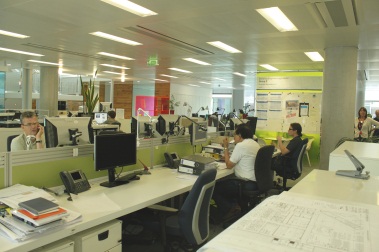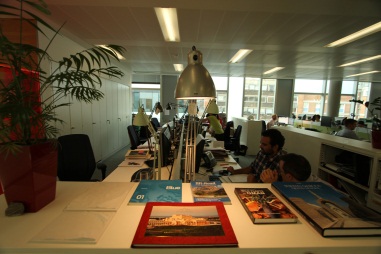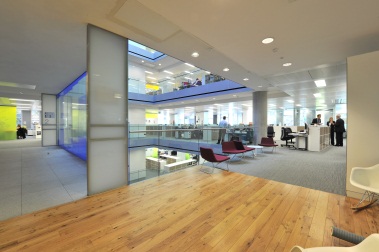The modern office environment is constantly evolving, with many organisations making frequent revisions to layouts and seeking to achieve a balance between open-plan working and private space, while catering for the different needs of individual employees.
With this in mind, lighting specialists often talk about task lighting as a flexible solution and claim that it has the added benefit of being energy efficient. After all, you can pick up, turn off and move a task light in a way that simply isn’t possible with a recessed 600 x 600 luminaire. And isn’t it better to provide office workers with low light levels and the option of switching on an additional light rather than providing them with an overlit workspace with no option to dim down?
This was the type of question Arup Lighting had in mind when it recently joined forces with one of its building engineering teams to conduct a study into the use of task lighting in its own office environment at 13 Fitzroy Street in central London.
‘We started by understanding that Category A overhead lighting is quite wasteful because it lights at quite a high level and uniformity,’ says Jonathan Ward, associate director at Arup Building Engineering. ‘We wanted to look at the opportunities to reduce energy, give people more autonomy and have a bit more variety in the workplace.’

How low can you go? Arup’s study revealed the majority of its staff were able and content to work with dimmer ambient lighting than is generally used in the office environment
Trend recognition
The study took place in a 21m-wide office with windows at both ends, providing access to daylight, but where some people sit as far as 9m from a window, explains Ward. An area of 80 desks formed the basis of the project, and employees were provided with a range of 17 different task lights from manufacturers including Humanscale, Luxo, Aktiva and Flos, with either a desk base or rail mounting.
The study highlighted a number of interesting trends, based either on data collected around the use of task lighting and energy consumption or anecdotal feedback from employees. One of the most notable is that energy consumption reduced by around 30 per cent, mainly as a result of the overhead lighting being dimmed down to around 200 lux.
‘The overhead lighting could be running at up to 12W/m2 [before being dimmed down] and, even if all the desk lights were on and left on overnight, they were only using a fraction of that - in the worst case 1W/m2,’ says Ward. He adds that greater use of controls on the overhead lighting could have led to further decreases.

Low glare Well-shielded lights such as Luxo’s Classic L-1 were popular with Arup employees
Different strokes
Part of this reduction, however, was because of employees’ tendency to only turn on the task lighting when necessary. Indeed, during a typical daytime - the study was conducted during late spring and early summer - only 10-20 per cent of individuals would use the task lighting, says Ward. In addition, many employees would make better use of Venetian blinds before turning the lamps on.
That people are quite happy to work in darker conditions than most offices provide comes as no surprise to Shane Cohen, global director of lighting at task-lighting manufacturer Humanscale. ‘You can have someone who is 30 sitting next to someone who is 60 and how they understand lighting is very different,’ he says. ‘The challenge is that a lot of the time they can’t control things such as overhead lighting. Almost every office space has two, three or four times too much ambient lighting.’
Use of task lighting varied according to what people were doing, says Ward, with those working on drawings or marking documents more likely to use the lamps than those using computers. This tallies with the experience of Richard Wells, senior designer at Aktiva, which often supplies desk-based task lights to environments such as libraries.
‘When we go to libraries where we’ve supplied lights, all the students have the lights on,’ he says. ‘Maybe that’s to do with libraries being slightly darker than a working office, but it would be interesting to know whether there is any long-term effect on eyesight if you’re working in 200 lux for 30 years and whether productivity is affected in a brighter or less-illuminated area.’
Another interesting finding was that users tended to prefer screen or rail-mounted luminaires to desk-based options.
‘We had a 50:50 split between desk-based and rail-mounted lights and one person had a desk base and swapped it for a bracket to put on the rail behind his desk,’ says Ward. ‘That does two things: it lifts it off the desk and gives you a greater degree of freedom in where you locate the light. Quite a few people were interested in getting it above the screen, higher than the eye line. If I was involved in an exercise to specify, I would now say go for the rail-mounted version.’
This, though, goes against what some of the manufacturers are saying. ‘You need to have it below eye height to avoid glare,’ says Lars-Fredrik Forberg, concept manager for office, healthcare and education at Glamox Luxo Lighting. ‘It’s also important that the task light or light source is well shielded to avoid direct glare to yourself or colleagues. I would argue the best height for a task light is 40cm, just below the eye line.’
Well-shielded lights were preferred by the majority of employees, says Ward, highlighting Luxo’s classic L-1 as a popular choice among staff members. ‘When you have a big shade, the LED resource is recessed up into the shade so it has a really good cut-off, and that’s generally appreciated by people,’ he says. Interestingly, there was little feedback around source colour, although some users did complain that point sources could cause distracting reflections.






